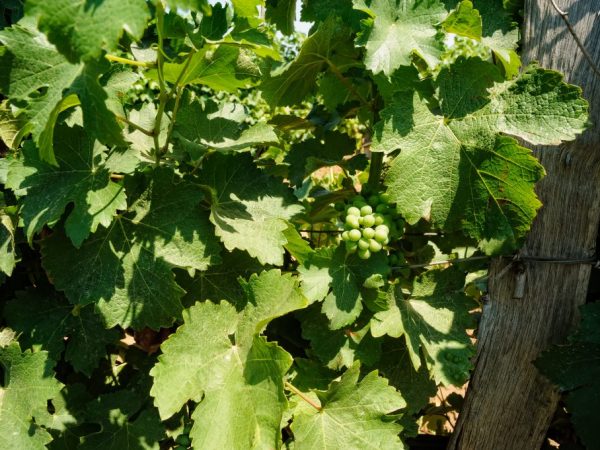Growing grapes Black pearls
The unusual Black Pearl grape is often found in the gardens. It is characterized by a large number of advantages that attract the attention of gardeners. Interest in this variety began to arise due to its unusual taste.

Growing grapes Black pearls
Variety characteristic
The Black Pearl grape variety has an average ripening period. Harvesting time falls at the beginning of autumn. This variety belongs to frost-resistant crops and is able to withstand temperatures of -26 ° C. If the temperature drops a little more, then the amount of the crop is reduced.
Sweetness is distinctly audible in the taste. There are small indicators of acid, which give the berries a piquant taste and aroma.
Suitable for making dessert wine, raisins or fruit salads.
The grapes contain 300 kcal per 100 g.
External and taste parameters of the fruit
Description of Black Pearl grapes:
- the description indicates that the Black Pearl gives a large yield: from 1 hectare to 130 kg of berries;
- berry weight 30 g;
- formed bunches are presented in a cylindrical shape, weighing up to 1 kg;
- berries of a dark blue hue, with a transparent structure;
- the pulp is light green, juicy.
Bushes of medium height, up to 3 m. The color of the leaf plate is dark green, with a pronounced edge. The length of the petiole exceeds the size of the central vein. A small edge is presented on the shoots.
Growing rules
Planting is best done in elevated and well-lit areas of the garden. This will allow the plant to receive the right amount of sunlight and not retain moisture in the root system. The minimum depth of groundwater is 3 m. Otherwise, a drainage system is installed at the bottom of the hole. Before planting the planting material, it is better to add a small amount of humus and compost to the soil (10 kg / m²). Under the condition of a high acid content in the soil, liming of the site is carried out (3 kg / m²).
It is better to plant Black Pearl grapes in loamy lands or black earth. A planting hole is prepared in advance, the dimensions of which are 80x100 cm. The deeper you plant the seedling in the hole, the more chances it has to survive the harsh winters. The root collar must be at a height of 5 cm from the surface of the earth. At the bottom of the hole, 5 kg of crushed stone or expanded clay are poured so that the drainage helps to remove excess moisture from the ground. 10 kg of compost is poured over the drain to feed the soil. A grafted and healthy seedling is treated with a humate solution to protect it from earth pests. A small embankment is made inside the pit, up to 30 cm high. Planting material is placed in it and sprinkled with earth, to a height of 30 cm. The remaining part of the hole is sprinkled with 5 kg of humus and thoroughly rammed. Since the plant grows tall, it is best to tie the seedling to a metal support to protect the bush from deformation.

The bush must be tied to a support
The distance between the bushes should be at least 3 m.A distance of 4 m is kept between the rows.This condition allows the bushes not to shade each other, which has a positive effect on the timing and quality of fruiting.
Care activities
Black Pearl grapes need high-quality watering and feeding. It is better to water every 20 days. For this, boiled, settled water at room temperature is used. This will help improve traction between roots and soil. The first watering is carried out 2 years after planting. Gardeners give the seedling time to take root and take root. After watering, the top layer of the earth is loosened thoroughly and weeds, which are considered carriers of parasites, are removed.
Top dressing is carried out as the plant develops. When forming bunches, potassium nitrate is added under the root (100 g for each bush). In the middle of summer, the vineyard is fed with a solution of ammonium nitrate (1 tbsp. L. For each bush) to increase the yield. A few weeks before harvesting, top dressing is carried out using superphosphate (20 g per 10 l of water). In autumn, if severe frosts are expected, mulch the soil with a mixture of straw and humus (1: 1).
Pruning is carried out in early June. During it, all dry branches and a vine damaged by parasites are removed. The eyes should remain, and the antennae should be removed. Often cut off the vine, which got out of the common bush.
Protection from pests and diseases
Despite its resistance, this species is often affected by mildew and powdery mildew. A solution of Bordeaux liquid (2 g per 5 liters of water) will help get rid of mildew. In the fight against powdery mildew, a manganese solution (5 g per 5 l of water) helps.
Of the pests, an invasion of ticks is noted. Several methods are used to combat them.
- Ladybugs are settled, which destroy ticks.
- Spraying with colloidal salt (20 g per 10 l of water) is carried out.
They are found on cushion bushes, the solution of copper sulfate helps to get rid of them (30 g per 5 liters of water).
Conclusion
The description indicates that this grape variety will not only decorate your garden, but also delight you with its taste. By adhering to the rules of care and cultivation, you will receive a rich and healthy harvest.


